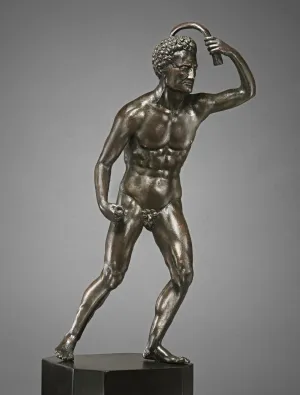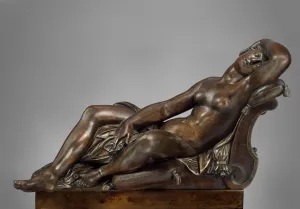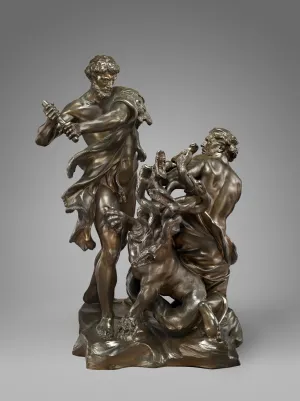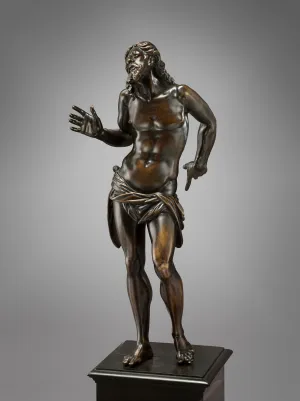Bronzes
All works in the collection of Mr. and Mrs. J. Tomilson Hill
Andrea Briosco, known as Riccio (Trent, Italy 1470–1532 Padua)
Strigil Bearer
Cast ca. 1515–20
Bronze
12 5/8 in. (32 cm)
Riccio was celebrated in Padua as an ancient sculptor reborn. This athlete bearing a curved strigil (skin scraper) and oil vial used for grooming the body is Riccio’s interpretation of a bronze statue (known solely through ancient texts) by the Greek sculptor Lysippus.
Attributed to Hermes Flavius de Bonis, called Lysippus (Padua ca. 1450/55–after 1526 Gazzuolo, Italy)
Hercules Resting
Cast early 1490s
Brass
9 1/4 in. (23.5 cm)
In the university town of Padua, the noble courts of Mantua and Rome, and Medici Florence, erudite collectors prized bronze statuettes for their evocation of the vanished grandeur of antiquity.
Attributed to the scholar and portrait-medalist Hermes Flavius de Bonis, Hercules Resting is a recreation of a lost, monumental bronze statue by Lysippus that was known from classical copies. By assuming the nickname “Lysippus,” the medalist compared his artistry to that of Alexander the Great’s personal sculptor.
Attributed to Maso Finiguerra (Florence 1426–1464 Florence)
Hercules and Antaeus
Cast ca. 1460
Brass
9 7/8 in. (25.2 cm)
This miniature recreation of a monumental, fragmentary ancient Roman marble depicts the moment when Hercules defeats Antaeus by hoisting the giant off the ground and breaking his back in his arms. In a tour-de-force of bronze casting that rivals a Herculean feat, the sculptor has composed the figure group to balance on its own without support.
The compositional daring and emotional power of this statuette is inversely proportional to its size. Its superlative detail indicates that its author, like many Renaissance masters of bronze, was trained as a goldsmith.
Unknown Italian artist
Écorché or Artist’s Model for St. Bartholomew or St. Jerome
First half of sixteenth century
Bronze
11 7/8 in. (30.3 cm)
Intended as models for both fellow artists and physicians, écorchés (flayed figures) challenged Renaissance sculptors to articulate the body’s exposed muscles and delineate their interaction. This figure, who rests his foot upon a skull, may be the apostle Bartholomew who was martyred by flaying. His large, closed eyes—unusual for an écorché—and expression of longing transform an anatomical model into a compelling work of art.
Willem Danielsz. van Tetrode (Delft? ca. 1525–1580 Wedinghausen, Germany)
Samson Slaying a Philistine
Probably modeled in Florence in 1562
Bronze
14.5 inches (37.5 cm)
Not in catalogue
Wielding the jawbone of an ass, the biblical hero Samson slew thousands of Philistine warriors, and in Medici Florence, he symbolized princely power. This work was modeled by the Dutch marble carver Tetrode to demonstrate his skill. The interlocked nudes form a pyramid that rests on a four-square base, a stable composition suggesting that Tetrode may have intended this group for a monumental marble. If so, it would have rivalled Michelangelo’s uncompleted statue of the subject.
Giambologna (Douai, France ca. 1529–1608 Florence)
Astronomy
Cast early 1570s
Bronze
15 1/4 in. (38.8 cm)
Given as gifts by Florentine Medici princes to rulers across Europe, Giambologna’s statuettes influenced a generation of sculptors. This personification of Astronomy stands in a hipshot pose, leaning on a plinth and resting her foot above a celestial globe. Her sinuous rotation invites viewers to admire her in the round.
Giambologna (Douai, France ca. 1529–1608 Florence)
Bull
Cast 1573, by Girolamo di Zanobi Portigiani
Bronze, with original oval base
8 1/2 x 10 1/4 in. (21.7 x 26 cm)
Surviving ancient small bronzes of sacrificial bulls are not uncommon, and this statuette may have been created in emulation of them. The bull’s majestic proportions and noble bearing may also reflect its use as an emblem by Cosimo I, the founder of the grand ducal Medici dynasty. This is a pristine bronze cast — its details were not sharpened in the metal with engraving tools. The hair on the bull’s head, his fleshy dewlap, swishing tail, and quizzical gaze capture the vitality of Giambologna’s original wax model.
Giambologna (Douai, France ca. 1529–1608 Florence)
Pacing Horse
Cast ca. 1573–77, by Girolamo di Zanobi Portigiani
Bronze
9 7/8 x 11 1/4 in. (25.1 x 28.7 cm)
This Renaissance warhorse is powerful in proportion, disciplined in stride, and immaculately groomed from clipped mane to bound tail. By depicting a riderless steed, Giambologna celebrates the innate nobility of horses, affording his subject the same status as classically idealized nudes. Like the Bull, this cast captures the vibrant syncopation of contour and form that is characteristic of Giambologna’s early bronzes.
Antonio Susini (Florence 1558–1624 Florence)
Hercules Slaying a Centaur
After a model by Giambologna, cast ca. 1600–1610
Bronze
15 3/4 in. (40.2 cm)
Rotating his body like a fulcrum, Hercules pins down the centaur while swinging his club. The centaur’s forelegs collapse as he struggles against the killing blow. Dramatic force builds when the sculpture is viewed in the round, culminating in the contrast between the hero’s concentration and the centaur’s scream.
Antonio Susini (Florence 1558–1624 Florence)
Rape of a Sabine
After Giambologna’s marble group of 1583, cast ca. 1585
Bronze
23 1/4 in. (59 cm)
Giambologna’s monumental marble Rape of a Sabine (Loggia dei Lanzi, Florence) features three intertwined figures that allow no single dominant viewpoint. He claimed that he had created it solely to “demonstrate the excellence of his art,” and it was, in fact, immediately celebrated as his crowning achievement. Bronze reductions, such as this early example from the master’s workshop, spread the statue’s fame.
Antonio Susini (Florence 1558–1624 Florence)
Cristo Morto (The Dead Christ on the Cross)
After a model by Giambologna of ca. 1588, cast ca. 1590–1615
Gilt bronze
12 1/4 in. (31 cm)
Giambologna modeled this figure of the dead Christ as a lithe, beautiful nude whose crucified body retains a sense of vibrant animation. His principal assistant, the goldsmith Antonio Susini, cast the model in bronze and tooled the metal’s surface with delicate precision. Brilliant gilding in precious gold honors the divine character of Christ’s sacrificial death.
Antonio Susini (Florence 1558–1624 Florence)
Mars
After a model by Giambologna of ca. 1565–70, cast ca. 1600–1608
Bronze
15 5/8 in. (39.5 cm)
Sighting the enemy, Mars halts his stride and swings his sword arm backward to attack. This statuette of the god of war symbolized princely power.
As sculptor to the Medici grand dukes of Florence, Giambologna established the benchmark for the late Renaissance bronze statuette. Mars is a superb example of the many that were cast from Giambologna’s model by his principal assistant, Antonio Susini. The figure’s polished craftsmanship and details, such as the refined engraving of Mars’s eyes and furrowed brow, evidence Susini’s skill.
Antonio Susini (Florence 1558–1624 Florence)
Sleeping Venus
After a model by Giambologna of ca. 1584, cast ca. 1600–1615
Bronze
8 1/4 x 12 1/4 in. (21 x 31 cm)
A classical Roman marble known as the Sleeping Ariadne inspired the pose of this Venus. Her slumbering, outflung abandon is Giambologna’s invention. The smooth precision of the figure, the angular drapery, and the detailed engraving of the eyes, fingernails, and embroidery are hallmarks of the bronzes that were cast and tooled by Giambologna’s principal assistant, the goldsmith Antonio Susini. Susini conveys the sensuous effects of flesh pressed against pillows and drapery folded by the motions of sleep.
Antonio Susini (Florence 1558–1624 Florence) and
Gianfrancesco Susini (Florence 1585–1653 Florence)
Hercules and the Hydra
After a model by Giambologna of before 1582, cast ca. 1614–24
Bronze
15 3/8 in. (39 cm)
In the Renaissance, Hercules’s exemplary feats — the Twelve Labors — symbolized princely virtue. This composition was modeled by Giambologna for a series of silver statuettes (now lost) for the state offices of the Medici grand dukes in Florence.
Gianfrancesco Susini (Florence 1585–1653 Florence)
Hercules and Antaeus
After a model by Giambologna, cast ca. 1625-1650
Bronze
16 1/8 in. (41 cm)
This bronze derives from Giambologna's models for a series of silver statuettes depicting the Twelve Labors of Hercules (now lost). Giambologna's principal assistant, Antonio Susini, and Antonio's nephew, Gianfrancesco, inherited the master's molds, reworked the models, and cast them in bronze well into the seventeenth century.
Ferdinando Tacca (Florence 1619–1686 Florence)
Ceres and Bacchus
Cast probably ca. 1635–40
17 3/4 in. (45.3 cm)
The smiling goddess of the harvest and the lord of the vine stride forward, heralding the promise of abundance, revelry, and love. Tacca’s statuette, like those by Piamontini in this gallery, exemplifies the novel subjects and immaculate craftsmanship that are characteristic of the finest Florentine Baroque bronzes. Ceres and Bacchus are united by their gaze and affectionate embrace and by the formal repetition of their graceful linear contours.
Giuseppe Piamontini (Florence 1664–1742 Florence)
Prince Ferdinando di Cosimo III on Horseback
Cast by 1717
Bronze
24 5/8 in. (62.5 cm)
Ferdinando, Grand Prince of Tuscany, is wigged and armored in the French style to associate his rule with the divine right of kings. He wields the baton of command as casually as he controls the fierce steed, underscoring his power. Piamontini’s virtuoso statuette of a ruler on a rearing horse was unprecedented in Florence. The daring design and flawless execution of this bronze reflect his artistic mastery, as well as the sitter’s sovereignty.
Giuseppe Piamontini (Florence 1664–1742 Florence)
Seated Hercules and Cerberus
Cast ca. 1715–25
Bronze
20 7/8 x 13 3/8 x 11 in. (53 x 34 x 28 cm)
Hercules has subdued Cerebus, the three-headed guardian of Hades, who howls in anger and bites the hero’s club. The pyramidal massing of figures makes Hercules appear as if he is a muscular mountain of bronze. The statuette’s sheer bulk contrasts with its precise tooling. Matte punches were used to differentiate textures and chisels to establish vibrating linear rhythms.
Giuseppe Piamontini (Florence 1664–1742 Florence)
Hercules and Iolaus Slaying the Hydra
After a model by Alessandro Algardi of ca. 1630, cast ca. 1700–1720
Bronze
12 3/4 x 9 1/8 in. (32.5 x 23 cm)
Hercules vanquished the hydra by lopping off its magically regenerating heads while his nephew Iolaus sealed the stumps with flames. Here, the figures circle around the twisting monster as Iolaus gazes in terror, not knowing if the battle can be won. Piamontini adapted this composition from a large-scale sculpture by Alessandro Algardi.
Giuseppe Piamontini (Florence 1664–1742 Florence)
Milo of Croton
Cast ca. 1725–30
Bronze
17 1/4 in. (43.6 cm)
The ancient Roman author Valerius Maximus tells of how Milo of Croton tested his strength against that of a riven oak only to be pinned within it and perish. Piamontini portrays Milo’s anguish as he struggles against the tree, his feet sliding beneath him, and discovers his power useless. Piamontini’s masterful rendering of a helplessly suspended heroic figure emphasizes the tale’s moral on the downfall of pride.
Hans Reichle (Schongau, Germany 1570–1642 Brixen, Italy)
Christ at the Column
Cast ca. 1610
Bronze
8 3/8 in. (21.4 cm)
Reichle studied in Florence with Giambologna and in his native Germany created statuettes following the practices of his teacher. Here, Reichle adapts the Italian devotional subject of Christ standing alone at the column to suit his German audience, which favored emotional depictions.
Alessandro Algardi (Bologna 1598–1654 Rome)
Cristo Vivo (The Living Christ on the Cross)
Model dated ca. 1646; a life-time cast
Bronze
33 in. (83.7 cm)
Algardi depicts Christ sacrificing himself on the cross to redeem mankind. Twisted, billowing draperies echo the pain contained within the Savior’s idealized, outstretched body. Christ directs his gaze toward God, his calm features expressing submission rather than agony. Algardi’s compelling depiction was modeled as a gift for Pope Innocent X. Bronze casts like this superlative example, which reflect the fervent tenor of Catholic devotion, became the most popular crucifixes in Baroque Rome.
Willem Danielsz. van Tetrode (Delft? ca. 1525–1580 Wedinghausen, Germany)
Mars Gradivus
Cast probably late 1560s
Bronze
15 5/8 in. (39.5 cm)
The lure of classical antiquity and the promise of patronage drew northern artists such as Tetrode and his contemporary Giambologna to Italy. The pose of Tetrode’s Mars Gradivus derives from an ancient sculpture, but the heavy musculature, flowing hair, and moustache reflect contemporary northern ideals.
Adriaen de Vries (The Hague ca. 1545–1626 Prague)
Bacchic Man Wearing a Grotesque Mask
Cast ca. 1578–80, probably by Giovanni Andrea Pellizzone (Milan ca. 1538–after 1610 Milan)
Bronze
35 1/4 in. (89.5 cm)
This ferocious nude hidden behind a grotesque mask personifies Bacchus, the god of wine and theater. Surmounting a fountain, he presided over a Milanese academy dedicated to the pursuit of artistic freedom during the repressive years of the Catholic Reformation. The depiction of Bacchus as a frightening, muscular figure who crushes grapes like a workman was unprecedented. Attributed to the youthful Adriaen de Vries, this extraordinary bronze was made to shock and to inspire creativity.
Hubert Gerhard (’s-Hertogenbosch, The Netherlands? 1540/50–ca. 1621 Munich?)
Orion
Cast probably before 1581
Bronze
10 1/4 in. (26 cm)
Orion’s lion skin and the sword and club he originally carried identify him as the mythical star-crossed lover who was transformed into a constellation by Jupiter. The detailed modeling of the figure’s rippling musculature reflects Gerhard’s knowledge of anatomy. Orion’s tilted head, arched torso, and angled arms accentuate the bodily play of sinews and muscles. This revealing pose was common to anatomical models such as the Écorché. Gerhard most likely studied such models in preparation for this delicately executed statuette.
Hans Reichle (Schongau, Germany 1570–1642 Brixen, Italy)
Christ at the Column
Cast ca. 1610
Bronze
11 7/8 in. (30.2 cm)
Reichle studied in Florence with Giambologna and in his native Germany created statuettes following the practices of his teacher. Here, Reichle adapts the Italian devotional subject of Christ standing alone at the column to suit his German audience, which favored emotional depictions.
Caspar Gras (Bad Mergentheim, Germany 1585–1674 Schwaz, Austria)
Roaring Lion, Pouncing
Model dated ca. 1630s, cast before 1674
Bronze
8 1/2 x 9 1/4 in. (21.6 x 23.7 cm)
One of only four known casts, this bronze was once one of a pair that included a Kicking Horse (J. Paul Getty Museum, Los Angeles). It is a rare example of the invention and technical daring that German masters like Gras contributed to the Italian tradition of animal statuettes. Gras boldly depicts the king of beasts poised in mid-leap, attacking the horse from below.
Circle of Ponce Jacquiot (Rethel, France before 1536–1570 Paris)
Diana
Model created after 1556, cast before 1585
Bronze
13 3/4 in. (34.8 cm)
Diana, virgin goddess of the hunt, runs while turning to grasp an arrow to notch into her bow (now lost). The heavy folds of her leather tunic swirl in counterpoint to her balletic movements. This exquisitely detailed statuette is a free interpretation of an ancient Roman marble statue of Diana (Musée du Louvre, Paris) that Pope Paul IV gave to King Henry II in 1556. The bronze goddess’s nubile proportions, bejeweled hair, and entrancing gaze reflect the ideal of female beauty at the French royal court.
Barthélemy Prieur (Berzieux, France 1536?–1611 Paris)
Lion Devouring a Doe
Cast probably before 1583
Bronze
6 1/4 x 13 3/8 in. (16 x 34.1 cm)
In his youth, Prieur may have traveled to Rome for his artistic studies. Upon his return to Paris, he became one of the foremost sculptors of his generation. His elegant statuettes responded to the desire, then new in France, to collect bronzes in the “Italian manner.” The Lion Devouring a Doe is Prieur’s interpretation of famous statuettes by Giambologna and his followers that depict a lion attacking a stallion.
Barthélemy Prieur (Berzieux, France 1536?–1611 Paris)
Rearing Horse
Cast before 1611
Bronze
8 1/4 x 8 3/4 in. (21 x 22.2 cm)
A gifted animal sculptor, Prieur introduced the Italian art of the statuette to his native France. His inventories of 1583 and 1611 list models of dogs, goats, stags, cows, bulls, lions, and horses. The composition of the Rearing Horse presented a daunting challenge because it required the sculpture’s weight to be balanced on the two points of the horse’s back hooves. The subject was so difficult that during the late Renaissance it came to symbolize the art of sculpture. This example from Prieur’s workshop exhibits the formal stylization typical of the master.
Hubert Le Sueur (Paris ca. 1580–1660 Paris)
Venus
Cast ca. 1641–60
Bronze
17 7/8 in. (45.4 cm)
Le Sueur was sought after by the kings of France and England for his ability to cast monumental bronze sculpture, and he probably created statuettes while working on these commissions. The Venus is loosely based on large-scale ancient statues depicting the nude goddess shielding herself (Venus pudica). The statuette’s hesitant pose and inward expression heighten the effect of modesty. Viewed from the back, the goddess’s posture emphasizes her ample, sensual grace. King Louis XIV displayed this bronze in his Medals Cabinet.
Unknown French artist
The Assumption of the Virgin
Second half of seventeenth century, after a 1647 engraving of a 1644 painting by Simon Vouet, cast ca. 1650–1700
Bronze
18 3/4 x 12 1/4 in. (47.4 x 31.2 cm)
Lifted by cherubim, the Virgin rises from her tomb while the apostles look up in astonishment. The sculptor based his composition on an engraving, and he expertly employed his repertoire of tools to achieve the bronze relief’s pictorial effects. He sharpened the figures’ flaring robes with chisels, creating a sparkling contrast of light and shadow that offsets the polished backdrop of pilasters, steps, and tomb. Meticulous matte punching conveys the cloudburst’s radiance.
Probably commissioned by François Girardon (Troyes, France 1628–1715 Paris)
Sleeping Hermaphrodite
1699–1709
Bronze cast after a terracotta model attributed to François Duquesnoy (1597–1643)
Original carved gilt-wood base attributed to Gilles-Marie Oppenord (1672–1742)
8 1/4 x 9 1/8 x 17 1/8 in. (21 x 23.2 x 43.5 cm)
Girardon was sculptor to King Louis XIV, as well as a renowned collector. This bronze and its companion, Reclining Venus, were cast from terracotta models in his collection. Duquesnoy’s terracotta Hermaphrodite was a reduction of a famous Roman marble antiquity. The Venus was modeled by a student of Nicholas Poussin. Girardon had these figures made as a bronze pair to celebrate the achievement of the founders of French classicism.
Probably commissioned by François Girardon (Troyes 1628–1715 Paris)
Reclining Venus
1699–1709
Bronze cast after a terracotta model attributed to Thibault Poissant (1605–1668)
Original carved gilt-wood base attributed to Gilles-Marie Oppenord (1672–1742)
9 3/8 x 9 1/4 x 16 3/4 in. (24 x 23.5 x 42.5 cm)
Reclining on their original gilt-wood couches, the Reclining Venus and Sleeping Hermaphrodite are intact examples that preserve the sumptuous character of statuettes made during the reign of Louis XIV. The figures were displayed as a pair. When viewed from the back, each appears female. When viewed from the front, the hermaphrodite’s dual male and female nature is revealed. The languorous beauty of the dreaming figures seduces and deceives. Grinning masks at the feet of their golden beds are emblems of duplicity.


































